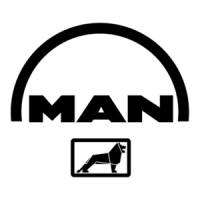Tuning Wheel / Torsional Vibration Damper
A tuning wheel or torsional vibration damper may
have to be ordered separately, depending on the
final torsional vibration calculations.
Connecting Rod
The connecting rod is made of forged and pro-
vided with bearing caps for the crosshead and
crankpin bearings.
The crosshead and crankpin bearing caps are se-
cured to the connecting rod with studs and nuts
tightened by means of hydraulic jacks.
The crosshead bearing consists of a set of
thinwalled steel shells, lined with bearing metal.
The crosshead bearing cap is in one piece, with
an angular cutout for the piston rod.
The crankpin bearing is provided with thinwalled
steel shells, lined with bearing metal. Lube oil is
supplied through ducts in the crosshead and con-
necting rod.
Piston
The piston consists of a piston crown and piston
skirt. The piston crown is made of heatresistant
steel and has four ring grooves which are
hardchrome plated on both the upper and lower
surfaces of the grooves.
The piston is bore-cooled and with a high topland.
The piston ring pack is No. 1 piston ring, high CPR
(Controlled Pressure Relief), Nos. 2 to 4, piston
rings with angle cut. All rings are with Alu-coat on
the running surface for safe running-in of the pis-
ton ring.
The uppermost piston ring is higher than the oth-
ers. The piston skirt is of cast iron with a bronze
band.
Piston Rod
The piston rod is of forged steel and is surface
hardened on the running surface for the stuffing
box. The piston rod is connected to the crosshead
with four bolts. The piston rod has a central bore
which, in conjunction with a cooling oil pipe, forms
the inlet and outlet for cooling oil.
Crosshead
The crosshead is of forged steel and is provided
with cast steel guide shoes with white metal on
the running surface.
The guide shoe is of the low friction design.
The telescopic pipe for oil inlet and the pipe for oil
outlet are mounted on the guide shoes.
Scavenge Air System
The air intake to the turbocharger takes place
directly from the engine room through the turbo-
charger intake silencer. From the turbocharger,
the air is led via the charging air pipe, air cooler
and scavenge air receiver to the scavenge ports
of the cylinder liners, see Chapter 14.
Scavenge Air Cooler
For each turbocharger is fitted a scavenge air
cooler of the monoblock type designed for sea-
water cooling at up to 2.0 2.5 bar working pres-
sure, alternatively, a central cooling system can be
chosen with freshwater of maximum 4.5 bar work-
ing pressure.
The scavenge air cooler is so designed that the
difference between the scavenge air temperature
and the water inlet temperature at specified MCR
can be kept at about 12 °C.

